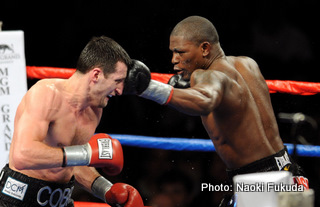 “Sometimes when you win, you really lose, and sometimes when you lose, you really win, and sometimes when you win or lose, you actually tie, and sometimes when you tie, you actually win or lose. Winning or losing is all one organic mechanism, from which one extracts what one needs.” – Rosie Perez, White Men Can’t Jump
“Sometimes when you win, you really lose, and sometimes when you lose, you really win, and sometimes when you win or lose, you actually tie, and sometimes when you tie, you actually win or lose. Winning or losing is all one organic mechanism, from which one extracts what one needs.” – Rosie Perez, White Men Can’t Jump
April 27, 2009 – By Scott Kraus: The fighter, crumpled in the corner of the ring, blood streaming from his mouth, limbs splayed, eyes cloudy, seemingly down for the count, somehow rises to face a further barrage of blows he no longer has the strength to defend, willing himself to make the final bell, until the referee mercifully waves his arms to signal the end of the fight.
By definition, Jermain Taylor was a loser following his title fight against Carl Froch. However, more than any other sport, results in boxing tell a very incomplete story – in this case, one man won the fight and one man lost, but both men left the ring having gained something..
Taylor has lost three of his last four fights, two of them by brutal knockout. On paper, it is a record of failure. In the ring, however, Taylor’s performances and behavior tell another story.
In his first loss to then-undefeated Kelly Pavlik, Taylor had Pavlik badly hurt and nearly stopped in the second round. Pavlik survived, and the two traded thunderous power punches until Pavlik hurt Taylor badly with an uppercut in the seventh. Taylor crumbled in the corner as Pavlik attacked and referee Steve Smoger stopped the fight with Pavlik crowned the new middleweight champion.
Pavlik-Taylor was a Fight of the Year candidate, a fight in which Taylor demonstrated his terrific strengths early, only to offer the most concrete proof to date of his Achilles heels – his stamina and chin.
Struggling to make the middleweight limit, Taylor chose to move up in weight following his first loss. For most fighters coming off a devastating knockout loss, that would mean a carefully chosen opponent to restore confidence and public image. For Taylor, it meant a rematch with Pavlik at 166 pounds, without the middleweight championship at stake.
His desire to avenge a devastating defeat, as well as the roster of opponents he faced since ascending to the top of the middleweight division, speak to Taylor’s heart and intentions in boxing. As middleweight champion, he beat Bernard Hopkins again in a rematch, fought Winky Wright to a draw, and lost to Pavlik, the best opponents around in the middleweight ranks.
His other two defenses, against Kassim Ouma and Corey Spinks, received criticism for both Taylor’s lackluster performances and the smaller size of his opponents. However, Ouma was a former junior middleweight titlist, Spinks was a former welterweight world champion and junior middleweight titlist, and both were far more legitimate opponents than Gary Lockett and Marco Antonio Rubio, the two future footnotes Pavlik has faced for his championship.
After losing a decision to Pavlik and rebounding with a solid decision win against Jeff Lacy, Taylor again suffered a devastating knockout in the title bout against Froch. As with Pavlik, Taylor knocked Froch down early and had him in serious trouble in the third round. As with Pavlik, his failure to finish a hurt opponent would haunt him later in the fight.
The two knockout losses were not total mirror images, however. Against Froch, Taylor led by four points going into the final round. Although he was clearly fading and Froch was gaining the advantage, Taylor never stopped fighting back. Against Froch, Taylor got a chance to demonstrate his heart in the ring, and he demonstrated all the heart a fan could ask in the final two rounds.
Taylor, exhausted and absorbing punishment, did not have to rise from the crushing knockdown he suffered in the twelfth, when his tank was clearly empty. Yet he did, and he managed to throw some right hands by instinct before Froch trapped him against the ropes and teed off with combinations until referee Mike Ortega stopped the bout with 14 seconds remaining.
Fourteen seconds separated Jermain Taylor from victory. He could have held and danced and ran in the twelfth round, surviving and leaving the fight in the hands of the judges, but he chose to fight. That choice may have cost him a title, but ultimately the knowledge he gained about himself in rising from the canvas and finishing on his feet, the courage he showed by refusing to quit in the face of tremendous adversity, could prove far more valuable in the future, both in and out of the ring.